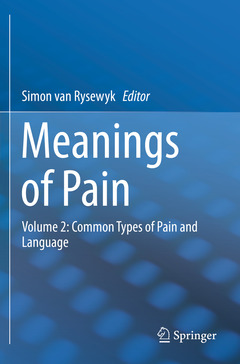Description
Meanings of Pain, 1st ed. 2019
Volume 2: Common Types of Pain and Language
Coordinator: van Rysewyk Simon
Language: English
Subject for Meanings of Pain:
Keywords
Publication date: 09-2020
Support: Print on demand
Publication date: 09-2019
Support: Print on demand
Description
/li>Contents
/li>Biography
/li>Comment
/li>
Experiential evidence shows that pain is associated with common meanings. These include a meaning of threat or danger, which is experienced as immediately distressing or unpleasant; cognitive meanings, which are focused on the long-term consequences of having chronic pain; and existential meanings such as hopelessness, which are more about the person with chronic pain than the pain itself.
This interdisciplinary book - the second in the three-volume Meanings of Pain series edited by Dr Simon van Rysewyk - aims to better understand pain by describing experiences of pain and the meanings these experiences hold for the people living through them. The lived experiences of pain described here involve various types of chronic pain, including spinal pain, labour pain, rheumatic pain, diabetic peripheral neuropathic pain, fibromyalgia, complex regional pain syndrome, endometriosis-associated pain, and cancer-related pain. Two chapters provide narrative descriptions of pain, recounted and interpreted by people with pain.
Language is important to understanding the meaning of pain since it is the primary tool human beings use to manipulate meaning. As discussed in the book, linguistic meaning may hold clues to understanding some pain-related experiences, including the stigmatisation of people with pain, the dynamics of patient-clinician communication, and other issues, such as relationships between pain, public policy and the law, and attempts to develop a taxonomy of pain that is meaningful for patients. Clinical implications are described in each chapter.
This book is intended for people with pain, their family members or caregivers, clinicians, researchers, advocates, and policy makers.
Chapter 1: Exploring the Meanings of Pain: My Pain Story.- Chapter 2: After the Tango in the Doorway: An Autoethnography of Living with Persistent Pain.- Chapter 3: Diagnosing Human Suffering and Pain: Integrating Phenomenology in Science and Medicine.- Chapter 4: “Pain Takes Over Everything”: The Experience of Pain and Strategies for Management.- Chapter 5: Changing Pain: Making Sense of Rehabilitation in Persistent Spine Pain.- Chapter 6: “Let Me Be a Meaningful Part in the Outside World”: A Caring Perspective on Long-Term Rheumatic Pain and Fear-Avoidance Beliefs in Relation to Body Awareness and Physical Activities.- Chapter 7: The Importance of Pain Imagery in Women with Endometriosis-Associated Pain, and Wider Implications for Patients with Chronic Pain.- Chapter 8: Labour Pain.- Chapter 9: Living with Complex Regional Pain Syndrome: Understanding the Battle.- Chapter 10: Cancer Pain and Coping.- Chapter 11: Common Meanings of Living with Diabetic Peripheral Neuropathic Pain from the Perspective of Patients.- Chapter 12: Connotations of Pain in a Socio-Psycho-Biological Framework.- Chapter 13: Is “Chronic Pain” a Meaningful Diagnosis?.- Chapter 14: The Meaning of Pain Expressions and Pain Communication.- Chapter 15: On Saying it Hurts: Performativity and Politics of Pain.
Simon van Rysewyk is a University Associate in the Department of Philosophy and Gender Studies, School of Humanities, University of Tasmania. He received his PhD in Philosophy from the University of Tasmania in 2013. From 2013 to 2014, he was a Taiwan National Science Council Post-Doctoral Fellow in the Brain and Consciousness Research Center and Graduate Institute of Medical Humanities, Taipei Medical University, Taiwan. His interests are pain, meaning, phenomenology, and experiential research methods.
He is coeditor of the 2015 Springer title "Machine Medical Ethics," Vol. 74, in the series "Intelligent Systems, Control and Automation: Science and Engineering," ISBN 978-3-319-08108-3. He has edited the 2016 contributed volume "Meanings of Pain", the first book in a three-volume series published by Springer.
These books may interest you

Meanings of Pain 179.34 €

Meanings of Pain 179.34 €

Muscle Pain: Diagnosis and Treatment 348.14 €

